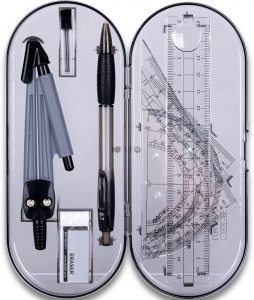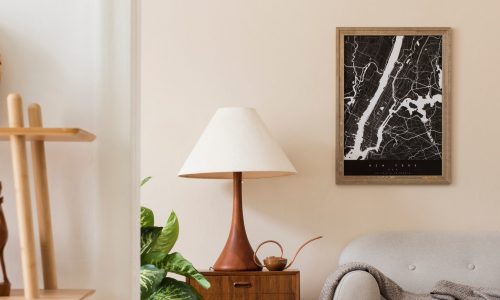The Best Compass & Protractor Set

Our Review Process
Don't Waste Your Money is focused on helping you make the best purchasing decision. Our team of experts spends hundreds of hours analyzing, testing, and researching products so you don't have to. Learn more.
Our Picks For The Top Compass & Protractor Sets
- 1. Unjoo Educational Compass & Protractor Set, 10-Piece
- 2. MeetUs STEM Compass & Protractor Set, 8-Piece
- 3. Helix Oxford Safety Point Compass & Protractor Set, 9-Piece
- 4. Westcott Grip Top Compass & Shatter Resistant Protractor Set, 2-Piece
- 5. Fiskars Locking Mechanism Compass & Clear Protractor Set, 2-Piece
- 6. Mr. Pen Metal Compass & Swing Arm Protractor Set, 15-Piece
- 7. Charles Leonard Office Compass & Protractor Set, 2-Piece
When back to school shopping, you won't want to miss this compass & protractor set. All 10 pieces within the set are designed to help your student master geometry. What's even better is that all of the tools are neatly organized and presented in a handy storage case.
Multiple Color OptionsYou'll find this compass & protractor set comes in six fun colors, including green, orange, red and navy blue.
Whether you're studying geometry or engineering, this compass & protractor set is a must-have tool. The set features a total of eight pieces, including two triangle rulers, a straight ruler, a protractor and a graphic compass. It's also travel-friendly and small enough to fit in the front pouch of your backpack.
For All Skill LevelsThis compass & protractor set comes with a reusable pouch to keep all of your tools neat and organized.
You’ll get nine tools in this English-made compass & protractor set, as well as a classic-looking metal tin for storing everything. The kit includes a self-centering compass, pencil, ruler, protractor, set squares, stencil, eraser, sharpener and a timetable that includes a fact sheet. The pencil sharpener has an antitamper screw, and the comp...
A Serious KitThis instrument kit has everything a serious math student needs to start learning geometry.
An easy-grip top makes the compass easy to use. You can draw circles of up to 13 inches in diameter with two-sided, 6-inch measurement. The 180-degree protractor has a 6-inch ruler and shatter-resistant plastic to ensure it lasts.
Show Your StyleAvailable in a variety of colors, this compass & protractor set is ideal for students who want to show their own unique style.
Buying Guide
Signing up for a geometry class means you’ll likely need two essential supplies: a compass and a protractor. The compass is used to draw circles and arcs, while the protractor helps you measure and make plane angles.
You can buy either of these tools at your local office supply store or even some grocery and discount department stores. If you just need these tools to get you through a semester or two of high school geometry, the plastic versions sold in these locations will likely do just fine. But if you’re committing to a multiyear education that includes engineering or architecture classes, it might be worth investing in a more durable set.
In a compass, steadiness is key to success. If you have a compass that slips while you’re using it, your arcs will be wobbly. Having one that’s easy to adjust for different angles will also come in handy. The more time you’ll spend with your compass, the more important those features will be.
Your compass will also need a pencil. Some compasses come with a pencil, but you may eventually have to replace it. Pay close attention to the build of your compass and make sure you can find a writing implement that fits. You’ll also need an eraser since compass pencils typically don’t come with one. This will give you the leeway you need to make mistakes while you’re learning.
Protractors are fairly simple tools, but there are still some features that are important. Complicating things is the fact that there are multiple types of protractors. In a classroom environment, a semicircular protractor is most common, featuring two types of scales, each displaying a scale that goes from 0 to 180 degrees in opposite directions. There are also 360-degree protractors that form a full circle and military protractors used for determining likely enemy positions on maps.
For serious mathematicians, there are sets that include protractors and compasses, along with other tools. Such kits can give you the extras you need, including spare lead, a sharpener for the pencil, a stencil and a square. These tools may not be something you’ll use every day, but they can be handy to have around.
What to Look For
- Both compasses and protractors come in different materials, from plastic to steel. The latter can be more durable, but the former may be all you need for your geometry class.
- Protractors can have varying ranges, with some making larger circles than others. Look into this before you buy.
- Holding a compass in position will tire your hand. Some come with a locking mechanism that provides an added layer of convenience. Some compasses even have easy-grip tops to reduce hand fatigue while you use them.
- The measurement marks are everything when it comes to protractors. Some feature bold lines and numbers to make them easy to read.
- In geometry, you’ll need to be able to measure in both inches and centimeters. Make sure your protractor can help with both measurement types.
- Compasses and protractors are typically provided in neutral colors, with protractors being clear or metal and compasses being black or metal. But you can find these tools in bright, vivid colors if you want to express your personal style.
- If you opt for a plastic protractor, look for one made from durable, shatter-resistant plastic to avoid having to replace it soon after.
- If you need to buy for multiple children, or you’re purchasing math sets for your own classroom, you can buy them in sets. This might help you save some money, but most importantly, it will let you ensure everyone’s working with the same tools.
- Before class starts, you might want to invest in a scientific calculator, as well as some graph paper. These supplies will come in handy as you do your geometry work.
More to Explore
If you enjoy geometry class, you have Euclid to thank. Often credited as the father of geometry, Euclid authored the influential textbook “Elements,” which was used in math education until the early 1900s.
Although Euclid’s work was done around 300 B.C., historians have found evidence that ancient Egyptians used geometric equations, which puts the subject’s origins as far back as 3000 B.C.E. Many of the buildings and artwork in ancient Greece were also believed to have been created using geometric principles.
The compass got its start as the “sector” in the 16th century. It was developed to perform mathematical calculations and eventually evolved into the compass that’s in use today.

















